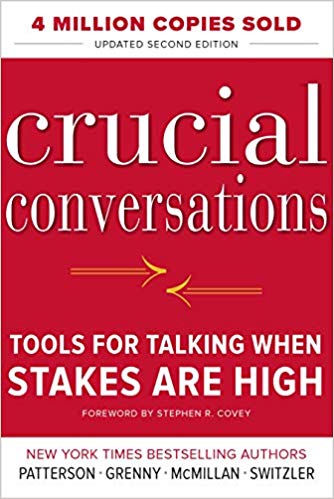

This article is an excerpt from the Shortform summary of "Crucial Conversations" by Kerry Patterson. Shortform has the world's best summaries of books you should be reading.
Like this article? Sign up for a free trial here .
How do you “move to action” in crucial conversations? When you move to action, do crucial conversations stop?
When you have a crucial conversation, the next step is to turn your conversation into action. But before you move to action in crucial conversations, you have to decide on the next steps to make sure they fit into your plan for everything you discussed.
Move to Action in Crucial Conversation: From Conversation to Results
Once everyone contributes his or her information to a crucial conversation, the final step is action. All the conversational effort is moot unless there’s an action plan and follow-through to achieve results. This is a critical turning point at which new challenges can come up.
Groups often fail to convert the ideas into action and results for two reasons:
- They aren’t clear on how decisions will be made.
- They fail to act on the decisions they do make.
This chapter focuses on what it takes to move from ideas to action.
Transitioning from Dialogue to Decision-Making
In order to move to action in crucial conversations, you have to collectively decide how to move forward. If you don’t clarify the conclusions and decisions emerging from the discussion, you can run into unmet expectations later on.
Problems develop in two ways:
- People don’t understand how decisions will be made. You may have agreed to something in principle, but not to any specific actions (yet people may act and be surprised when others object).
- Sometimes no decision gets made. Ideas fade or people can’t get a handle on implementing them — or everyone is waiting for someone else to decide.
Decide How You’ll Decide
To avoid these two problems, you need to decide how you’ll decide.
Dialogue isn’t decision-making. It’s a process for gathering all relevant information, which involves everyone. But the fact that someone has shared their input doesn’t mean they’ll get to participate in all decisions.
To prevent misunderstanding, it’s important to separate talking from decision-making: Make clear how decisions will be made, who will make them, and why.
Here are the typical starting points where you can move to action in crucial conversations.
Situation 1: When the line of authority is clear
When you’re in a position of authority you decide which method of decision making you’ll use.
For example, managers and parents decide how to decide; it’s part of their responsibility as leaders. Vice presidents don’t ask hourly employees to decide pricing changes or product lines. Parents don’t ask kids to set their own curfew or make household decisions.
Leaders can turn decision making over to direct reports when warranted, but the person in authority still decides what method of decision making to use. Deciding what decisions to turn over and when is part of their stewardship.
Situation 2: When there’s no established line of authority
When there’s no clear line, deciding how to decide can be quite difficult.
For example, if a teacher wants to hold your child back a year but you object, who decides? Who makes the decision should be discussed in the group. If you don’t talk and opinions differ, you’ll end up in a dispute. When authority is unclear, decide together how you’re going to decide.
Move to Action in Crucial Conversations With the Four Methods of Decision Making
Once you have a plan, the next step to move to action in crucial conversations is to pick a decision-making method. Four common ways of making decisions are: command, consult, vote, and consensus. They reflect increasing degrees of involvement. Increased involvement brings greater commitment but decreased efficiency. The method you use depends on the circumstances.
Command
With command decisions, it’s not your job to decide what to do, only how to make it work. Decisions are made without others’ involvement.
Use this method when:
- Outside forces dictate what happens. For instance, agencies mandate safety standards, or other governing bodies or “higher ups” issue demands. Bosses often pass on the demands of others, rather than having independent authority.
- It makes sense for you to delegate the decision — it’s a low-stakes issue in which you don’t need to take part. You trust the person you designate to make the right decision. Your involvement wouldn’t contribute anything additional.
Consult
Decision-makers invite input from others before they decide. They consult with experts, those affected, and anyone whose opinion would be relevant. This can be an efficient way of gaining ideas and support without bogging down the decision-making process. After gathering ideas, decision-makers evaluate the options, make a choice, and then inform the broader population.
Vote
Voting is appropriate where you have a number of good options, and want to decide in the most efficient way. Members of the team realize they may not get their preferred choice, but aren’t going to debate it.
Consensus
You talk until everyone agrees to one decision. This method has both pluses minuses. It can produce unity and good decisions, or it can be a waste of time.
It should be used only with:
- High-stakes and complex issues, or
- Issues where everyone must support the final choice.
Each decision-making method is a choice that you make when you decide to move to action in crucial conversations. Choose carefully, because it can affect the outcome of the whole conversation.
Conclusion — Move to Action, Achieve Results
How you are currently handling crucial moments when your actions can disproportionately affect your relationship or organization is determining the quality of your life and your effectiveness as a leader.
Next, take action. Identify a crucial conversation that you could improve right now, identify the principle and skill that will help, and try it. You needn’t be perfect, but if you persist, you will see dramatic improvement in your relationships and results.
At crucial moments, a little change can make a big difference.
Moving to action in crucial conversations can help a tough conversation become more positive. When you move to action, crucial conversations become productive forms of communication.

———End of Preview———
Like what you just read? Read the rest of the world's best summary of Kerry Patterson's "Crucial Conversations" at Shortform .
Here's what you'll find in our full Crucial Conversations summary :
- How to approach an argument without getting mad
- The mistakes most people make when trying to listen to someone else
- How to come up with win-win solutions that make everyone happy






